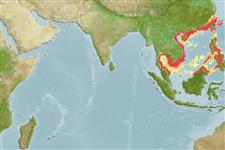>
Eupercaria/misc (Various families in series Eupercaria) >
Sillaginidae (Smelt-whitings)
Etymology: Sillago: From a locality in Australia .
Environment: milieu / climate zone / depth range / distribution range
Écologie
marin démersal; non migrateur; profondeur 10 - 50 m (Ref. 6205). Tropical; 28°N - 4°N, 98°E - 125°E (Ref. 6205)
Western Pacific: Taiwan to the Gulf of Thailand. This species is possibly widespread. Sillago soringa is almost certainly a senior synonym of Sillago asiatica.
Taille / Poids / Âge
Maturity: Lm ? range ? - ? cm
Max length : 15.0 cm SL mâle / non sexé; (Ref. 6205)
Épines dorsales (Total) : 12; Rayons mous dorsaux (Total) : 20 - 21; Épines anales: 2; Rayons mous anaux: 21 - 23; Vertèbres: 34. The swim bladder with three anterior extensions, the middle one projecting forward and the anterolateral ones recurved backward along the swim bladder; only single posterior extension is present. The head and body pale sandy brown to light fawn; belly is paler, almost white. An indistinct pale mid-lateral stripe is present on some specimens. The opercle and preopercle are transparent with a crescentic patch of black-brown spots in a pigmented area the shape of the gill arches on the inside of the gill cover, and showing through. The fins are hyaline; the margins of the unpaired fins finely spotted with brown; the upper and lower margin of the caudal fin dark brown to almost black.
Occur in inshore waters. Oviparous (Ref. 205). Taken as an incidental catch with other sillaginid species (Ref. 9679).
Life cycle and mating behavior
Maturities | Reproduction | Spawnings | Egg(s) | Fecundities | Larves
McKay, R.J., 1992. FAO Species Catalogue. Vol. 14. Sillaginid fishes of the world (family Sillaginidae). An annotated and illustrated catalogue of the sillago, smelt or Indo-Pacific whiting species known to date. Rome: FAO. FAO Fish. Synop. 125(14):87p. (Ref. 6205)
Statut dans la liste rouge de l'IUCN (Ref. 130435)
Menace pour l'homme
Harmless
Utilisations par l'homme
Pêcheries: intérêt commercial mineur
Outils
Articles particuliers
Télécharger en XML
Sources Internet
Estimates based on models
Preferred temperature (Ref.
123201): 24.1 - 29, mean 27.9 °C (based on 206 cells).
Phylogenetic diversity index (Ref.
82804): PD
50 = 0.5000 [Uniqueness, from 0.5 = low to 2.0 = high].
Bayesian length-weight: a=0.00575 (0.00272 - 0.01217), b=3.06 (2.89 - 3.23), in cm total length, based on LWR estimates for this Genus-body shape (Ref.
93245).
Niveau trophique (Ref.
69278): 3.2 ±0.4 se; based on size and trophs of closest relatives
Résilience (Ref.
120179): Haut, temps minimum de doublement de population inférieur à 15 mois (Preliminary K or Fecundity.).
Fishing Vulnerability (Ref.
59153): Low vulnerability (10 of 100).
